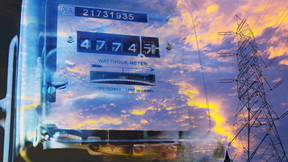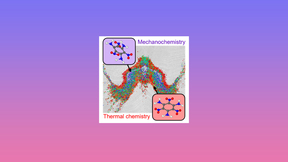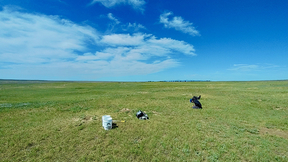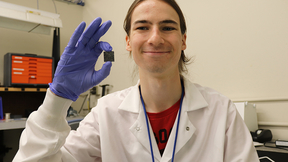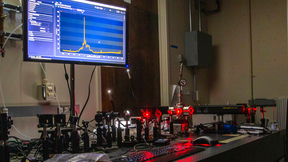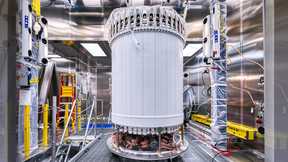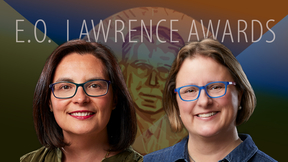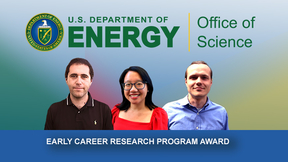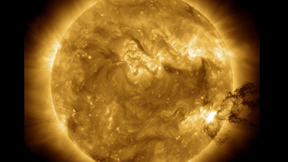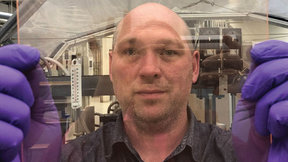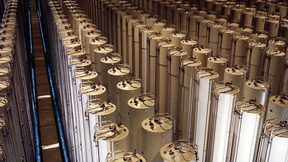Back
Physical and Life Sciences
An open-source, data-science toolkit for energy GridDS
As of 2020, 102.9 million smart meters — devices that record and communicate electric consumption, voltage and current to consumers and grid operators — have been installed in the United States. As the number of smart meters and the demand for energy is expected to increase by 50 percent by 2050, so will the amount of data those smart meters produce. While energy standards…
Research finds mechanically driven chemistry accelerates reactions in explosives
Scientists at the Lawrence Livermore National Laboratory (LLNL) Energetic Materials Center and Purdue University Materials Engineering Department used simulations performed on the LLNL supercomputer Quartz to uncover a general mechanism that accelerates chemistry in detonating explosives critical to managing the nation’s nuclear stockpile. Their research is featured in the…
Fabricating iron oxide with high phase purity
Various types of iron oxide (FeO) are typically distinguished by the number of iron and oxygen atoms coordinated with one another. However, specific iron and oxygen coordination is also an important factor to consider, as a molecule’s various phases can exhibit vastly different material properties. In recent years, epsilon-phase iron oxide (ε-Fe2O3), a rare polymorph of…
3D printing of transparent silicone elastomers
Additive manufacturing is essential to the production of advanced materials, providing a straightforward approach to rapid prototyping and manufacturing. Direct ink writing (DIW), a subset of additive manufacturing, offers a versatile route to ink extrusion—a processing method where a viscous ink is forced through a nozzle but behaves like a solid when printed on a…
Performing a cross-scaffold search for genomic islands
Gareth Trubl and researchers from Sandia National Laboratories have created a new computer tool called Tiger2 that scans DNA and looks for genomic islands—sections that look different than the surrounding DNA. Genomic islands are important for understanding life, infection, evolution, and more. These sections typically house antibiotic resistant and toxin producing genes…
Research reveals where carbon storage in soils has the most potential
Soil is the largest terrestrial reservoir of organic carbon and is central for climate change mitigation and adaptation. Mineral-organic associations play a critical role in soil carbon preservation, but the global capacity for storage in this form has never been quantified. New research from Lawrence Livermore National Laboratory (LLNL) and an international team of…
LLNL intern fabricates carbon aerogel structures for energy-storage applications
A visit to Lawrence Livermore National Laboratory (LLNL) last summer by a university professor led to a unique internship opportunity for an undergraduate student this summer: helping LLNL scientists fabricate higher-performing carbon aerogel structures for electrodes and other energy-storage applications. In 2021, Professor Anthony Santamaria from Western New England (WNE…
Oxygen effects on uranium tested
A team of researchers from Lawrence Livermore National Laboratory (LLNL) and the University of Michigan has found that the rate of cooling in reactions dramatically affects the type of uranium molecules that form. The team’s experimental work, conducted over about a year-and-a-half starting in October 2020, attempts to help understand what uranium compounds might form in…
LLNL cancer research goes exascale
A Lawrence Livermore National Laboratory (LLNL) team will be among the first researchers to perform work on the world’s first exascale supercomputer — Oak Ridge National Laboratory’s Frontier — when they use the system to model cancer-causing protein mutations. Led by Harsh Bhatia, a computer scientist in the Center for Applied Scientific Computing (CASC) at LLNL, the team…
Andean glaciers reacted in unison with polar ice in changing climate
For the first time, scientists have shown that glaciers in the tropical Andes mountains have been in sync with polar ice extent in Antarctica and the Arctic for nearly a million years. New research by an international team, including Lawrence Livermore National Laboratory (LLNL) scientist Christine Y. Chen, records glacier movement in the Southern Hemisphere that dates…
LUX-ZEPLIN Dark Matter Detector at Sanford Underground Research Facility delivers its first result
Deep below the Black Hills of South Dakota in the Sanford Underground Research Facility (SURF), an innovative and uniquely sensitive dark matter detector — the LUX-ZEPLIN (LZ) experiment, led by Lawrence Berkeley National Lab (Berkeley Lab) — has passed a check-out phase of startup operations and delivered its first results. In a paper posted online today on the experiment…
3D printing allows for faster charging and higher-energy-density lithium-ion batteries
The next generations of lithium-ion batteries require higher energy and power densities at a lower cost. Current battery manufacturing, based on slurry casting and coating, is struggling to further improve these key metrics. Lawrence Livermore National Laboratory (LLNL) is partnering with Ampcera Inc. to develop solvent-free Laser Powder Bed Fusion (L-PBF) additive…
Breaking the strongest chemical bonds with laser shock compression
Lawrence Livermore National Laboratory (LLNL) scientists recently obtained high-precision thermodynamic data on warm dense nitrogen at extreme conditions that could lead to a better understanding of the interiors of celestial objects like white dwarfs and exoplanets. The team, which includes researchers from the University of California, Berkeley and the University of…
Two LLNL scientists earn E.O. Lawrence Award
Two Lawrence Livermore National Laboratory (LLNL) scientists are recipients of the prestigious 2021 E.O. Lawrence Award that recognizes mid-career U.S. scientists and engineers for exceptional scientific, technical and engineering achievements related to the broad missions of the Department of Energy (DOE) and its programs. Jennifer Pett-Ridge was recognized for her…
Physics-based cryptocurrency transmits energy (not just information) through blockchain
Researchers from Lawrence Livermore National Laboratory (LLNL) have devised a physics-based cryptocurrency that links electrical energy and blockchain technologies in a new way. This new blockchain concept, dubbed “E-Stablecoin,” could allow electricity to be transmitted between users who are spread around the world, without the need for interconnecting wires or a grid…
DOE honors three early-career Lab scientists
Three scientists from Lawrence Livermore National Laboratory (LLNL) are recipients of the Department of Energy’s (DOE) Office of Science Early Career Research Program award. Mimi Yung, John Despotopulos and Timofey Frolov are among 83 awardees receiving the recognition. Under the program, typical awards for DOE national laboratory staff are $500,000 per year for five years…
Short Wavelengths Yield Big Dividends
Collaborative research and development focused on the extreme ultraviolet (EUV) end of the spectrum has resulted in state-of-the-art, multilayer reflective optics used for space exploration, manufacturing microchips, and more.
Additive Manufacturing Brings New Possibilities for Transparent Ceramics
Having developed several transparent ceramics for radiation detection applications for the Department of Homeland Security and the Stockpile Stewardship Program, Lawrence Livermore recently leveraged its unique additive manufacturing resources and capabilities to develop transparent ceramics with properties not previously available for use as laser materials.
The ACES in Our Hand
The Adaptive Computing Environment and Simulations (ACES) project will advance fissile materials production models and reduce risk of nuclear proliferation.
Going beyond Mother Nature’s molecules to target radioactive metals
Lawrence Livermore National Laboratory (LLNL) scientists and collaborators at Penn State University are improving natural molecules that would help target specific radioactive elements that are found in nuclear waste or used in nuclear medicine. Even the most effective molecules found in nature, which underwent billions of years of evolution, can still be improved for non…


